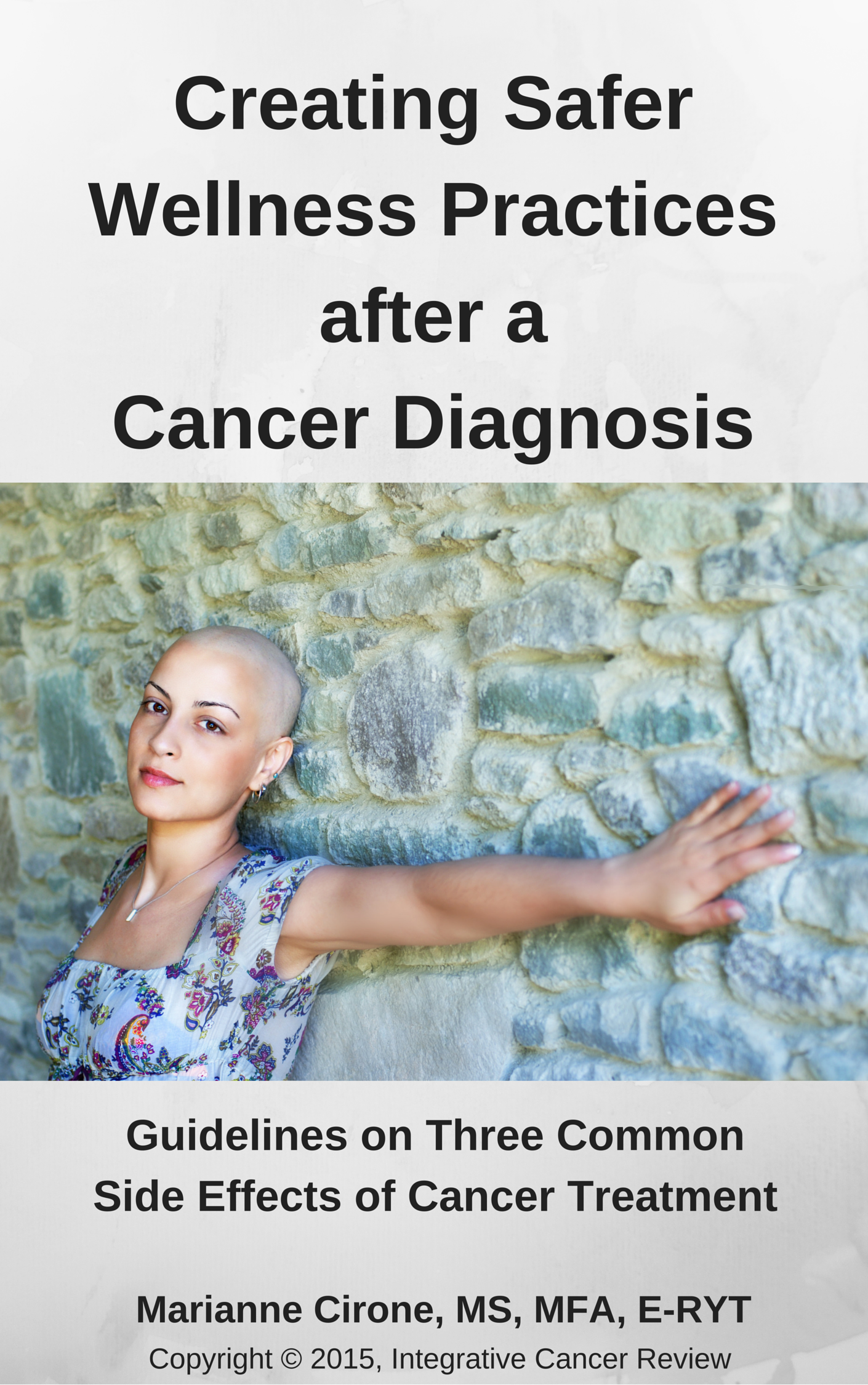
When I began my career in social work nearly twenty years ago, I never thought I’d be teaching mindfulness and yoga to people with cancer. Today, in addition to my career in academia, I volunteer to teach mindfulness workshops, meditation, and yoga to participants at Waterford Place Cancer Resource Center in Aurora, Illinois. Teaching at Waterford Place is pure joy and helps to sharpen my own mindfulness practices as each of my yoga classes differ, depending on the needs of those who attend class. Participants are in various stages of cancer treatment and their abilities and energy levels vary each week. I begin each class with an integration sequence or a beginning meditation that lasts about ten minutes. I ask participants to start where they are and feel free to move or adjust their positions, to find comfort, but to understand their intentions and what is triggering them to make adjustments. Then, I guide them through a sequence that always includes stretching the neck and shoulders as well as hip openers and gentle spinal twists, areas in which we tend to carry the most tension, as a cancer diagnosis often carries a weight of stress and anxiety.
 Dr. Kristen Esposito Brendel, Ph.D, LCSW, RYT graduated with a Ph.D in Social Work from Loyola University Chicago. Her research, teaching, and practice specialities include mindfulness-based practices and school-based interventions.
Dr. Kristen Esposito Brendel, Ph.D, LCSW, RYT graduated with a Ph.D in Social Work from Loyola University Chicago. Her research, teaching, and practice specialities include mindfulness-based practices and school-based interventions.
She is currently an assistant professor at Aurora University and owns and operates Per La Vita Wellness in Geneva, IL.
I had experienced firsthand how meditation practices helped me to reduce stress and anxiety while I was balancing family and career. I had started my career as a school social worker, and eventually opened a private practice before pursuing a career in academia. As my desire to implement evidence-based practices directly with clients or by proxy via my students, I found mindfulness-based interventions (MBI) as being one of the most effective interventions for many different diagnoses and client populations. MBI, simply stated, is paying attention to the moment, on purpose, with non-judgmental awareness. My own life experiences shaped my decision to understand and pursue my own mindfulness practice as well as research projects and teaching MBI to students and later clients.
I decided to further my quest to learn more about practicing and applying mindfulness with vulnerable populations that I enrolled in an eight-month yoga teacher-training program. I researched various yoga teacher-training programs, eventually deciding on attending the Sense of Samadhi program, because the owner of the studio, Tairi Grace, is also a licensed clinical social worker. After speaking to Tairi a few times about how she was integrating yoga and mindfulness practices, directly and indirectly with her client populations, I realized her program was the best fit for me.
I entered the yoga training program with few expectations. I wanted to be fully present and to try different things that challenged me. I didn’t intend on teaching yoga. Instead, I wanted to deepen my own practice and learn how to just let be. My only intention, outside of personal development, was to develop a graduate level course on mindfulness-based interventions, and I knew the yoga training would benefit my teaching methodology. During the summer of my yoga teacher training, I also participated in a formal eight-week mindfulness-based stress reduction program. I knew it was very important for teachers of mindfulness to also be practitioners of mindfulness. My formal training had me in a perpetual state of bliss. Not that I don’t still feel a range of emotions, but my recovery from negative events are much faster than I realized possible.
After finishing yoga teacher training, I developed a graduate level course in MBI, called Mindfulness-based Interventions for Clinical Social Work. It was offered for the first time three months after I graduated from yoga teacher training. My students were eager to register and the first offering had a wait list, so we offered two sections of the mindfulness course that term. As part of the theoretical coursework, students were required to develop their own mindfulness practices, which consist of an eight-week mindfulness-based stress reduction taught as part of the MBI curriculum. As a result of their practices, my students reported the same type of transformation that I had experienced when I went though yoga teacher training and the mindfulness-based stress reduction course: contentment, peace, bliss, non-reactivity, increased empathy, increased effectiveness in jobs and school, more happiness in relationships, and the sense of not being bothered by things that are normally frustrating.
As my students developed their own mindfulness practices and learned effective skill sets for working with clients, they also reported that their clients in their internships were also meeting success, experiencing changes such as decreased symptoms of depression, anxiety, stress, pain, and increased feelings of happiness. I became such a proponent of MBI that I wanted to shout it from the rooftops how effective these interventions can be! I began to hold workshops and seminars, guest teaching in classrooms, and working with athletes. I then created a private clinical practice solely focusing on MBI with individuals, groups, and the community. It is important to note that despite my enthusiasm for MBI, they are not a panacea, but they can be a primary or secondary intervention with many client populations. More and more research is being published each month as to the effectiveness of MBI with people with depression, anxiety, ADHD, chronic pain, and other health issues such as cancer.
As life has a way of putting skills to the test, my mother-in-law was diagnosed with inoperable cancer soon after I launched my new mindfulness courses. Due to a tragic car accident that had preceded her cancer diagnosis, she had not been physically or cognitively healthy before the diagnosis, and we all believed that the cancer would take her life. MBI helped to get my immediate family and me through the emotional roller coaster of my mother-in-law’s cancer diagnosis. During my own formal training, I had recruited my family to join me in meditations and to help me practice teaching yoga. Our previous experience with these mindfulness practices helped to keep us grounded and focused (mostly) on the present moment.
During my mother-in-law’s time in hospice, the mindfulness practices also kept us from going too far away, in our minds, from what we were experiencing. It didn’t make losing my dear mother-in-law any less painful; it still hurts. However, mindfulness did help to keep our anger and irrational thoughts at bay — thoughts and emotions which can only add to the pain of an already tragic situation. Through this life experience, I knew firsthand that MBI could benefit people with cancer and individuals in their support systems. The research supports my observations as well. A systematic review and meta-analysis conducted by Piet, Würtzen & Zachariae (2012) found that out of 1,403 cancer patients and survivors, mindfulness-based treatment was associated with significantly reduced symptoms of anxiety and depression from pre- to post-treatment [1].
Coincidentally, the Waterford Cancer Resource Center opened six months after my mother-in-law died. As soon as I heard about this facility, I volunteered to teach mindfulness workshops, meditation, and yoga to their participants. When I teach yoga at the cancer center, each class ends with a final relaxation (Savasana), which to me exemplifies the benefits of a mindfulness practice. Often, when participants are in Savasana, I look at each participant and silently pray for them, extending loving-kindness for their presence, for showing up. It is common for participants in any yoga class to shed a few tears during Savasana — I too have cried during my own yoga practice while in Savasana. For me, it is a happy cry, a release, as endorphins circulate through the mind, body, and spirit, while leaving one feeling whole, happy, and cared for. This has a special significance when teaching yoga to people with cancer. I know that the release they experience is about more than just a trying day. It is often the release of the mindset of labeling oneself as a patient, as well as the experience of enjoying some time of feeling good for a change.
After Savasana, I ring a soft bell. This is a non-verbal cue for my students to begin to make their way to a seated position, slowly and mindfully, and I conclude with an offering of loving-kindness and gratitude. I remind myself, and often overtly acknowledge, what types of transitions they have had to make in order to just show up for class. Some are getting out of the house, for the first and only time that day, to offer themselves self-care and compassion. I am overwhelmed and blessed to be a part of that process.
As a clinical social worker, my heart has grown and working as a mindfulness and yoga instructor at a cancer resource center has enriched my life. Meeting participants in their lives when they are the most vulnerable, and often uncertain about their future, is a gift I never expected. To think that I am able to help participants recognize that in this moment, where we are right now, that everything is okay; it is not only career defining, but also humanity defining.
[1] Piet, J., Würtzen, H. & Zachariae, R. (2012). The effect of mindfulness-based therapy on symptoms of anxiety and depression in adult cancer patients and survivors: A systematic review and meta-analysis. Journal of Consulting And Clinical Psychology, 80(6), 1007- 1020.
Brendel, K.E. (2010). Social work and meditation practice. PRAXIS, 10, 13-19.
Resources
Mindfulness-based stress reduction courses:
Per La Vita Wellness Geneva, Illinois
Center for Mindfulness: Online Course
Books:
Burch and Penman (2015). You Are Not Your Pain: Using Mindfulness to Relieve Pain, Reduce Stress, and Restore Well-Being—An Eight-Week Program.
Kabat-Zinn, J. (2013). Full catastrophe living.
Bartley & Teasdale. (2011). Mindfulness-based cognitive therapy for cancer.
Audio CD:
Free guided meditations:
UC San Diego Center for Mindfulness: Guided Audio Files to Practice Mindfulness Based Stress Reduction
UCLA Mindful Awareness Research Center: Free Meditation Podcasts
Insight Meditation Society: Podcasts & Guided Meditations
Finding the Space to Lead: Meditations & Reflections


















